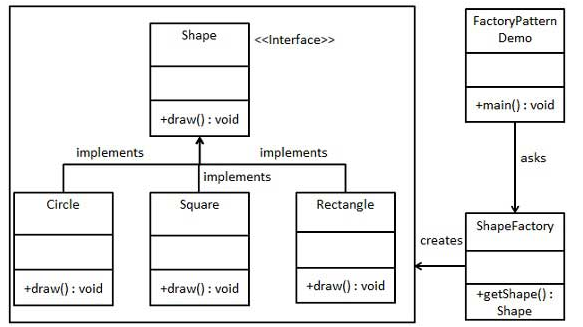介绍
意图:定义一个创建对象的接口,让其子类自己决定实例化哪一个工厂类,工厂模式使其创建过程延迟到子类进行。
主要解决:主要解决接口选择的问题。
何时使用:我们明确地计划不同条件下创建不同实例时。
如何解决:让其子类实现工厂接口,返回的也是一个抽象的产品。
关键代码:创建过程在其子类执行。
注意事项:作为一种创建类模式,在任何需要生成复杂对象的地方,都可以使用工厂方法模式。有一点需要注意的地方就是复杂对象适合使用工厂模式,而简单对象,特别是只需要通过 new 就可以完成创建的对象,无需使用工厂模式。如果使用工厂模式,就需要引入一个工厂类,会增加系统的复杂度。
例子:

步骤 1 创建一个接口。
package com.inter;
public interface Shape {
void draw();
}
步骤 2 创建实现接口的实体类。
package com.entity;
import com.inter.Shape;
public class Circle implements Shape{
@Override
public void draw() {
// TODO Auto-generated method stub
System.out.println("Inside Circle::draw() method.");
}
}
package com.entity;
import com.inter.Shape;
public class Rectangle implements Shape {
@Override
public void draw() {
// TODO Auto-generated method stub
System.out.println("Inside Rectangle::draw() method.");
}
}
package com.entity;
import com.inter.Shape;
public class Square implements Shape {
@Override
public void draw() {
// TODO Auto-generated method stub
System.out.println("Inside Square::draw() method.");
}
}
步骤 3 创建一个工厂,生成基于给定信息的实体类的对象。
package com.etcfactory;
import com.entity.Circle;
import com.entity.Square;
import com.entity.Rectangle;
import com.inter.Shape;
public class ShapeFactory {
public Shape getShape(String shapeType){
if(shapeType==null){
return null;
}
if(shapeType.equals("CIRCLE")){
return new Circle();
}else if(shapeType.equals("RECTANGLE")){
return new Rectangle();
}else if(shapeType.equalsIgnoreCase("SQUARE")){
return new Square();
}
return null;
}
}
步骤 4 使用该工厂,通过传递类型信息来获取实体类的对象。
package com.test;
import com.entity.Circle;
import com.etcfactory.ShapeFactory;
import com.inter.Shape;
public class FactoryPatternDemo {
public static void main(String[] args) {
ShapeFactory shapeFactory= new ShapeFactory();
Shape shape1=shapeFactory.getShape("CIRCLE");
shape1.draw();
Shape shape2=shapeFactory.getShape("RECTANGLE");
shape2.draw();
Shape shape3=shapeFactory.getShape("SQUARE");
shape3.draw();
}
}